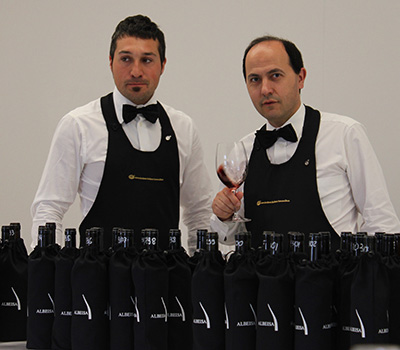A month ago, I had sampled twenty 2009s from Castiglione Falletto at a pre-release tasting held at the Cantina Comunale. Based on that, 2009 seemed a big, ripe, round vintage. Despite being just released (or just about to be), many of them were already approachable, suggesting a vintage more suitable for early (five to eight years) drinking than for extended aging.
I was not really surprised: 2009 was an odd year. It began with an extremely cold and snowy winter that lingered into a cool spring with higher than usual rainfall. Bud-break was late and flowering was disrupted by persistent rain resulting in uneven ripening of grapes. Summer arrived suddenly in early May with intense heat that continued through August and with periodic interruptions of rain. Temperatures began to drop in September but still remained higher than usual with some heavy rainstorms during the nebbiolo harvest.


First up were the Barolos from Serralunga. Due to compact clayey soil and predominantly western exposures, they are typically dark, concentrated, earthy and a bit backward. They’re often short on elegance and aroma but make up for that with a muscular structure and the ability to age. 2009 accentuated these qualities, or at least most of them. The majority of these wines are dark, nearly opaque, with a muted nose and concentrated fruit that unfolds on the palate with an almost creamy, mouth-coating texture. Because the polyphenols are muted, the alcohol often stands out (most of the 2009 Barolos clock in at around 14.5%). While many could benefit from a bit more time, my sense is that most of them would best be drunk fairly young before what little fresh fruit they have sinks once and for all into the murky depths.
In 2009, La Morra benefited from its mostly eastern exposures and lighter, looser soil. Some of the wines show a nice tautness and fresh strawberry acidity, like Rocche Costamagna’s Rocche dell’Annunziata, which is transparent brick red with pink highlights; its firm grape tannins yield to tart plum and an astringent, fresh rosemary finish. But many others are dark purple-black and over-extracted, with toasty new wood enclosing a mouthful of dense, over-ripe yet nondescript fruit. A few are able to pull off this heavier-handed approach with style, such as Mario Gagliasso’s Rocche dell’Annunziata. Despite its dark red-purple color and aromas of toasty wood and molten chocolate, it enters the palate with firm grip and restraint before gradually unveiling a series of flavors including dried cherry, tobacco and bay leaf. It finishes on supple tannins, which both give focus and indications of a promising future to come. For the most part, however (and putting stylistic preferences aside), 2009 is not a vintage that needs extra concentration or benefits much from heavy doses of new oak.
Based on the nearly forty Monforte Barolos at Nebbiolo Prima, this town fared much like Castiglione Falletto: solid, fleshy, well-balanced wines with dark, transparent maroon colors, ripe cherry and frutti di bosco flavors supported by supple tannins, and just enough acidity to keep them from falling flat. A good example is Silvano Bolmida’s Barolo Bussia, which starts out with a faint scent of allspice, cinnamon stick and lily bulbs. Firm tannins frame its solid core of black plum and blackberry with tart acidity and a nice dry finish.
The commune of Barolo showed quite nicely too. 2009 bestowed an extra bit of roundness, fleshiness and depth of color on these wines while still retaining their typical elegance and balance. A good example is Giuseppe Rinaldi’s Barolo Brunate-Le Coste, with its hint of smoked meat melting into ripe black cherries, black currants and dried violets. A series of flavors emerge on the palate from macerated fruit to supple leather and earthy tar, shaped by firm yet gentle tannins. The finish is dry and lingering. An enticing wine that straddles the fence between rusticity and elegance; this will reveal more of what it’s got as time passes.
This is a W&S web exclusive feature.
This is a W&S web exclusive. Get access to all of our feature stories by signing up today.















